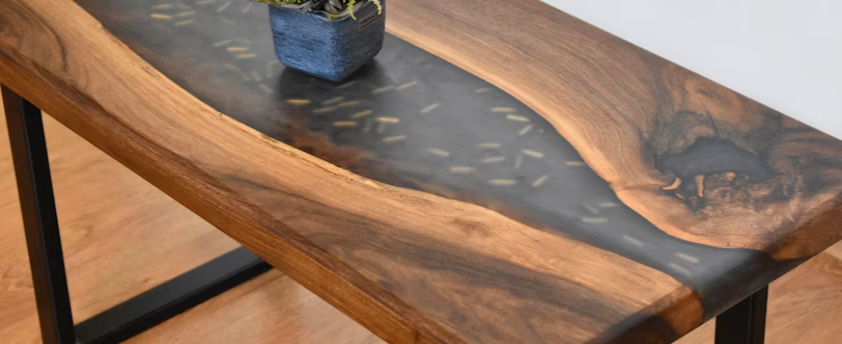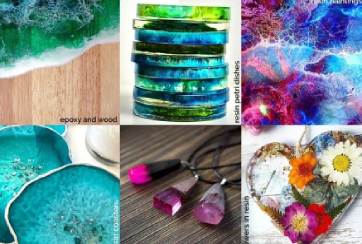Table of Contents
Epoxy Resin for Arts and Crafts: Understanding Basics and Properties
Discover the versatile applications of epoxy resin for arts and crafts. Epoxy resin is a synthetic liquid that, through a chemical reaction, hardens into a solid state. Composed primarily of epoxy polymers, it boasts strong adhesion, chemical resistance, and the ability to form durable, high-gloss finishes. These properties make it an excellent choice for various projects. With a chemical composition including an epoxy pre-polymer and a hardener, this material initiates a curing process, resulting in a rigid, durable material, perfect for creative endeavors.
One of the key characteristics of epoxy resin is its durability. Once cured, epoxy resin is known for its toughness and resistance to environmental factors such as moisture and UV light. This makes it ideal for creating long-lasting pieces. Additionally, its clarity and ability to hold vibrant colors without yellowing over time are highly valued in artistic applications. The versatility of epoxy resin allows it to be used in a wide range of projects, from jewelry making and painting to home decor and even furniture design.
There are various types of epoxy resins available on the market, each suited to different levels of experience and project requirements. For beginners, two-part epoxies are often recommended due to their ease of use and forgiving nature during the mixing and application process. Brands such as ArtResin, Pro Marine Supplies, and EnviroTex Lite are particularly suitable for those new to working with epoxy resin. These brands are known for their user-friendly kits, clear instructions, and reliable results, making them ideal for novice crafters.
Epoxy resin is favored by artists and crafters for its ability to create stunning, long-lasting pieces. Its high-gloss finish enhances the visual appeal of artwork, while its robust properties ensure the pieces remain intact over time. The recommended brands for beginners, such as ArtResin and Pro Marine Supplies, offer clear, bubble-free finishes and are easy to work with, making the creative process enjoyable and rewarding.
Epoxy resin can be utilized in numerous application areas. In jewelry making, it is used to create beautiful, custom pieces with embedded objects or vibrant pigments. In painting, epoxy resin can add a glossy, protective layer to artworks, enhancing their colors and depth. For home decor, epoxy resin is perfect for creating unique countertops, coasters, and other decorative items that are both functional and aesthetically pleasing. Its adaptability and impressive results make epoxy resin a staple in the toolkit of any artist or crafter.

Epoxy Resin for Arts and Crafts: Mixing, Processing, and Crafting with Epoxy Resin
Working with epoxy resin can be a rewarding experience, but it requires precision and attention to detail. To begin, it is crucial to mix epoxy resin correctly. Always follow the manufacturer’s instructions, as the resin-to-hardener ratio is essential for the curing process. Usually, the ratio is 1:1 or 2:1 by volume, but specific products may vary. Use accurate measuring cups and mix thoroughly for several minutes, scraping the sides and bottom of the container to ensure a uniform blend.
Adding color and dye to resin can create stunning effects. Pigment powders, alcohol inks, and resin dyes are popular choices. To achieve a marbled look, pour different colored resins together and gently swirl them. For a more uniform color, mix the dye into the resin before combining it with the hardener. Experiment with different techniques, such as the “dirty pour” or “flip cup,” to create unique patterns and textures.
During the mixing process, avoid common mistakes such as introducing air bubbles. Stir slowly and steadily to minimize bubbles, and consider using a heat gun or torch to eliminate any that rise to the surface. Also, be mindful of the working time of the resin; once mixed, you have a limited window before it starts to harden.
The processing phase involves techniques like sanding and polishing to achieve a smooth, professional finish. Start with coarse-grit sandpaper and gradually move to finer grits. Wet sanding can help reduce dust and achieve a clearer finish. Once sanding is complete, polish the resin with a polishing compound and a soft cloth to bring out its shine.
There are numerous beginner-friendly resin projects to explore. Resin art paintings involve pouring colored resin onto a canvas and manipulating it with tools or tilting the canvas. Petri dishes can be created by adding drops of alcohol ink into resin poured into silicone molds. Embedding flowers in resin requires drying the flowers first and then submerging them in resin within a mold. Jewelry, coasters, and rings are also popular projects; for these, you will need silicone molds, resin, and any decorative elements you wish to include.
When working with epoxy resin, safety is paramount. Always work in a well-ventilated area and wear protective gear, including gloves, goggles, and a respirator mask. Resin can be toxic if inhaled or if it comes into contact with skin. Keep your workspace clean and free of dust and debris to ensure the best results. By following these guidelines and best practices, you can enjoy a safe and fulfilling crafting experience with epoxy resin.





